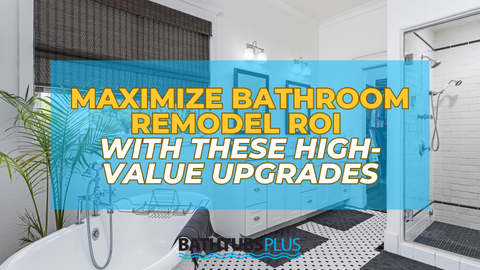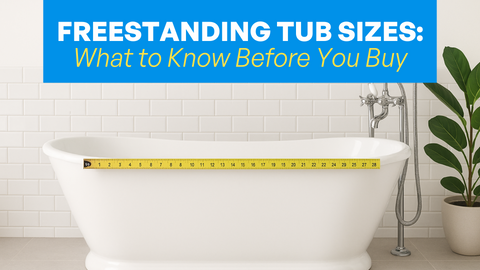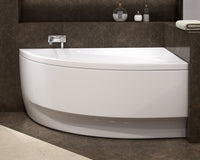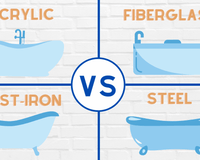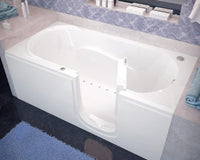What is an acrylic tub?
Acrylic tubs are sheets of clear plastic reinforced with fiberglass. With a slightly higher price tag compared to their fiberglass counterparts, these tubs offer an array of advantageous features. Their lightweight construction, coupled with exceptional durability, ensures longevity while demanding minimal upkeep.
Is acrylic bathtub good?
If you want bathtubs that last, acrylic tubs are a great option. Acrylic tubs, fortified with fiberglass, boast unmatched durability, ensuring years of worry-free enjoyment.
Low-maintenance and easily repairable, they're designed to stand the test of time, saving you from frequent replacements.
Different Types, Shapes and Sizes of Acrylic Tubs
Alcove acrylic tubs

Product featured: Grayley 60 x 32 Inch Alcove Bathtub in White [Price: $812]
An alcove acrylic tub is a bathtub type designed with an alcove-shaped enclosure. This configuration is similar to the standard drop-in design, commonly measuring around 60 inches in length, 32 inches in width, and 18 inches in height.
The alcove tub is specifically crafted to fit snugly within a three-walled space, providing a practical and space-efficient bathing solution for many bathrooms.
Oval or circular acrylic tubs

Product featured: American Acrylic 58" x 39" Drop-In Tub [Price: $1,782.80]
An oval acrylic tub is a drop-in or freestanding bathtub designed in an oval or circular shape, which has become increasingly popular among homeowners. These tubs typically measure around 60 inches in length, 41 inches in width, and stand at a height of 24 inches.
Corner acrylic tubs

Product featured: American Acrylic 60" x 60" Corner Tub [Price: $3,001.60]
A corner acrylic tub offers a touch of luxury for those seeking an elevated bathing experience. These bathtubs are designed in a full square shape and often serve as the foundation for hot tub-like setups.
In terms of dimensions, the average size of a corner tub measures approximately 60 inches in length, 60 inches in width, with a height of 22 inches.
Pros and Cons of an Acrylic Tub
Acrylic Tub Pros:
1. Good Heat Retention
Indulging in an acrylic bath is a true pleasure as these tubs boast a warmer touch, making them especially ideal for children and the elderly who may prefer to avoid the chill of metal baths.
2. Lightweight and Portable
Thanks to their lightweight composition, acrylic bathtubs are significantly easier to transport and maneuver. This feature allows for effortless lifting upstairs and placement in otherwise challenging positions. They also won’t need added floor support for a reliable installation.
3. Low-Maintenance
The beauty of an acrylic bath lies in its easy-to-maintain nature and non-porous surface. With proper care to prevent scratches, these baths maintain their pristine appearance for many years to come.
4. Flexibility and Customization
Acrylic baths boast a diverse range of shapes and sizes, providing ample flexibility for modern bathroom designs or even corner bath installations. Utilizing vacuum-formed techniques, acrylic baths can adopt various shapes, making them highly adaptable to different preferences.
5. Cheaper and Cost-Effective Option
Generally, acrylic baths come at a more budget-friendly price point compared to other materials. Manufacturers and retailers often include them in bathroom suite deals due to their cost-effective production. However, intricate designs may come with a slightly higher price tag.
Acrylic Tub Cons:
1. Prone to surface stains and scratches
One drawback of acrylic tubs is their vulnerability to staining and scratching when not properly maintained or cleaned. However, the good news is that these issues can be easily addressed through simple and inexpensive repairs.
2. Sensitive to some cleaning solutions/ harsh chemicals
Another downside of acrylic tubs is their sensitivity to abrasive cleaners, requiring careful consideration of the cleaning products used. Regular cleaning with appropriate, non-abrasive materials is necessary to avoid staining and scratching issues.
Additionally, while acrylic bathtubs are generally resistant to fading, prolonged exposure to direct sunlight or harsh cleaning chemicals may cause the color fading/ discolorations.
Pro-tip: To minimize this effect, it is advisable to position the acrylic tub away from direct sunlight or utilize curtains or blinds for protection and to maintain its pristine appearance.
3. May feel “hollow” and less luxurious
If you're seeking for the most luxurious and high-end option, acrylic tubs might not be the ideal choice. Although available in a diverse range of shapes and designs, and capable of meeting some high-end requirements, acrylic tubs may not match the opulence of certain other materials.
Additionally, some people may find that acrylic tubs feel hollow or less substantial compared to heavier and more solid options like steel or cast iron tubs.
FAQs about Acrylic Tubs

How to clean an acrylic tub?
To clean an acrylic tub, use a soft sponge or cloth and safe cleaning products. Rinse thoroughly and dry the tub. Regular cleaning can reduce the time spent on maintenance from one hour twice a year to just 10 minutes monthly.
Avoid using acetone or steel wire balls, as they may harm the surface. Instead, opt for safer options like baking soda, white vinegar, borax powder, and shampoo.
How to repair an acrylic tub?
Repairing an acrylic tub is a simple and cost-effective process. First, clean the tub thoroughly, then use fine-grit sandpaper to sand out minor scratches in a circular motion. Next, buff the sanded area with car wax to blend it with the rest of the tub's surface. For shallow surface scratches, toothpaste applied with a damp cloth can also help.
However, for deep cracks or significant damage, it is best to seek professional acrylic tub repair services. Always test any repair method on a small, inconspicuous area first to avoid potential damage, and handle the repair process carefully to ensure the best results.
Can you tile an acrylic tub?
In general, it is not recommended to directly tile an acrylic tub, as the tiles may not adhere securely, leading to potential tile detachment and the risk of voiding the tub's warranty.
Instead, a preferable alternative is to install a tub surround around the acrylic tub, not directly bonded to the tub itself, providing a more suitable and secure option for tiling in the bathroom area.
Can an acrylic tub be painted or resurfaced?
Acrylic tubs can be refreshed through professional reglazing or relining, though these options can be costly. However, there's a DIY alternative: consider purchasing an acrylic bathtub refinishing kit from your favorite home improvement store to revitalize the tub yourself.
Acrylic's versatility shines in its array of fade-proof color options, making it a perfect match for any color scheme. If you desire a color change, you can opt to paint the tub using a two-part epoxy paint. Prior to painting, take care to protect surrounding tiles and materials to prevent damage to the rest of your bathroom.
What is the average lifespan of an acrylic tub?
The lifespan of an acrylic tub is commendable due to its reinforced fiberglass construction, ensuring durability for years. Thanks to their easy maintenance and repairability, they can last even longer without requiring replacement.
However, being one of the more budget-friendly choices available, acrylic bathtubs generally have a shorter lifespan compared to other materials. On average, you can expect approximately 10-15 years of use from your acrylic bathtub before considering a replacement, primarily due to concerns like heavy discoloration or cracking.
CONCLUSION:
- If you're on a tight budget, choosing an acrylic bath is the most cost-effective option.
- For higher-level/ second floor installations, consider an acrylic bathtub due to its lighter weight.
- Need a bathtub for your small bathroom? Acrylic is one of the best material choices for combining bath and shower to save space.
- If you plan to re-enamel the bath in the future for a fresh look, acrylic is not the best option. Go for other materials like steel.
- If you're installing a bath primarily for resale value, go with acrylic.
Acrylic Tub Brands
For your acrylic tub needs, American Acrylic and Reliance Bath offers a diverse selection of tubs with various hydrotherapy features, including whirlpool and air massage systems, as well as simple soaking tubs without jets.
They provide tubs in different shapes and installation types, such as corner bathtubs, and alcoves. With eco-friendly materials and meticulous craftsmanship, these bathtub brands stand out as the top choice for premium acrylic tubs and bathroom products.



